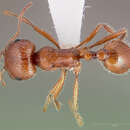en
names in breadcrumbs


Taxonomic history
Wheeler, 1914f PDF: 153 (q.m.); Taber et al., 1988 PDF: 51 (k.).Combination in Pogonomyrmex: Emery, 1895d PDF: 311.Junior synonym of Pogonomyrmex badius: Pergande, 1893 PDF: 33.Status as species: Cresson, 1887 PDF: 260; Dalla Torre, 1893 PDF: 109; Emery, 1895d PDF: 311; Pergande, 1896 PDF: 894; Forel, 1899b PDF: 63; Wheeler, 1902a PDF: 98 (in key); Wheeler, 1902d PDF: 391 (in key); Wheeler, 1902g PDF: 26; Wheeler, 1906i PDF: 341; Wheeler, 1910a PDF: 566; Wheeler, 1914f PDF: 153; Forel, 1914d PDF: 270; Emery, 1921c PDF: 46; Essig, 1926 PDF: 861; Tulloch, 1930a PDF: 61; Olsen, 1934 PDF: 502; Cole, 1937b PDF: 134; Creighton, 1950a PDF: 120; Smith, 1951c PDF: 793; Cole, 1954b PDF: 117; Cole, 1966b PDF: 4 (in key); Cole, 1968: 120 (redescription); Hunt & Snelling, 1975 PDF: 21; Smith, 1979: 1356; Snelling & George, 1979: 56; Dlussky, 1981b PDF: 48; Allred, 1982: 495; Snelling, 1982a PDF: 98; MacKay et al., 1985: 49; Wheeler & Wheeler, 1986g PDF: 31; Bolton, 1995b: 340; Taber, 1998: 151 (in key); Mackay & Mackay, 2002 PDF: 210; Ward, 2005 PDF: 67; Johnson & Overson, 2009 PDF: 313 (in key); Johnson et al., 2013 PDF: 225 (in key).Senior synonym of Pogonomyrmex californicus estebanius: Cole, 1968: 120; Smith, 1979: 1356; Snelling & George, 1979: 56; Bolton, 1995b: 340.Senior synonym of Pogonomyrmex hindleyi: Snelling & George, 1979: 56; Snelling, 1982a PDF: 98; Bolton, 1995b: 340.Senior synonym of Pogonomyrmex longinodis: Cole, 1968: 120; Smith, 1979: 1356; Snelling & George, 1979: 56; Bolton, 1995b: 340.Senior synonym of Pogonomyrmex californicus nitratus: Cole, 1968: 121; Smith, 1979: 1356; Snelling & George, 1979: 56; Bolton, 1995b: 340.
Pogonomyrmex californicus, or California harvester ant,[1] is a species of ant in the subfamily Myrmicinae. It is native to North America, where it occurs in the southwestern United States and northern Mexico.[2] It is best known as the ant that is sent out for Uncle Milton's Ant Farm.[3]
Pogonomyrmex californicus can be found in open, warm, and sandy areas. Typically, it forages during the day as individuals or in a group, forming columns as they work. It preys on arthropods, such as the larvae of the raisin moth (Cadra figulilella), and collects seeds. It can form colonies of hundreds of individuals. The nest entrances are often irregular and are surrounded by loose sand arranged in a circular or semi-circular pattern. Reproduction occurs around July, when reproducing individuals are present.[2]
Pogonomyrmex californicus forms multiple-queen colonies at times. Most colonies are founded and sustained by one queen, but one population has been noted to contain multiple queens in a cooperative, a phenomenon known as pleometrosis.[2]
The distribution of this ant extends from Texas to Utah to Baja California, Sonora, and Chihuahua.[2]
The Chumash people of California would sometimes use the species as an entheogen with which to initiate boys into manhood. The consumption of these ants was considered a safer method of inducing visions than the more usual method employed which involved the drinking of a brew prepared from the deliriant herb Datura wrightii. The ants were swallowed alive on eagle down and the venom injected in the stings that they inflicted on the mouths and throats of the boys would cause them to hallucinate. Around 250 ants constituted an effective dose.[4]
Pogonomyrmex californicus, or California harvester ant, is a species of ant in the subfamily Myrmicinae. It is native to North America, where it occurs in the southwestern United States and northern Mexico. It is best known as the ant that is sent out for Uncle Milton's Ant Farm.